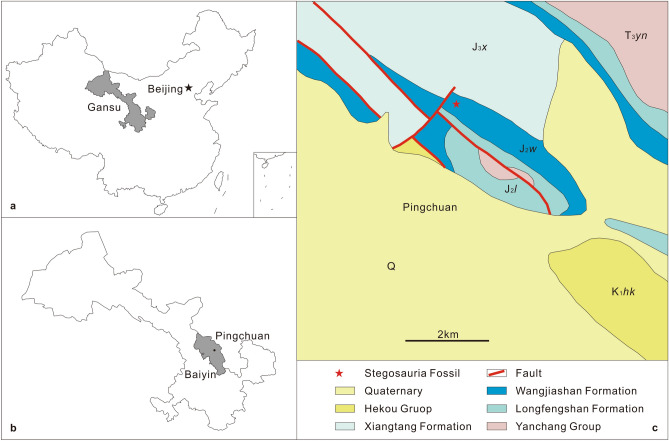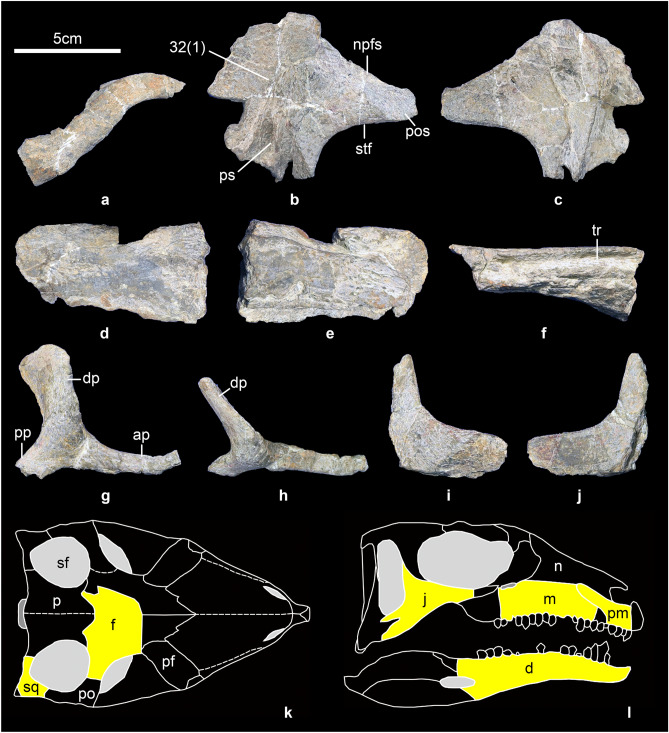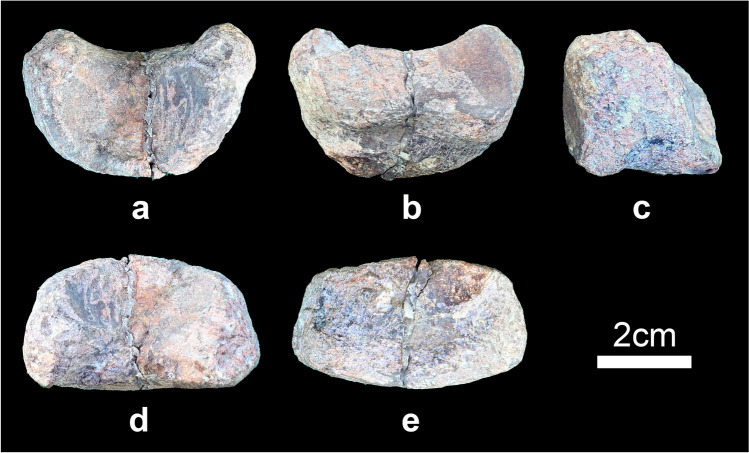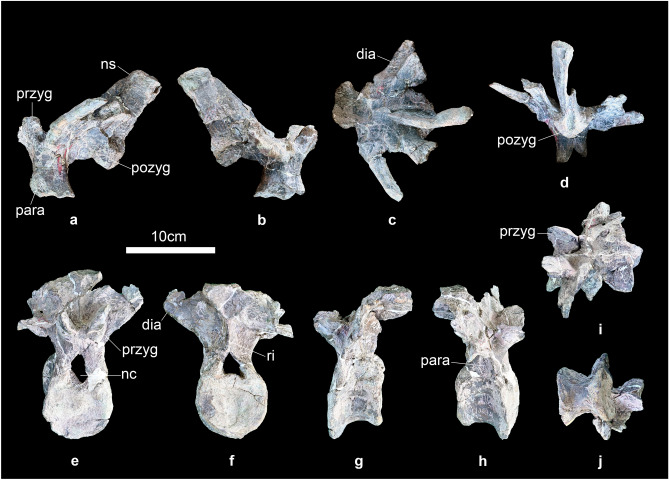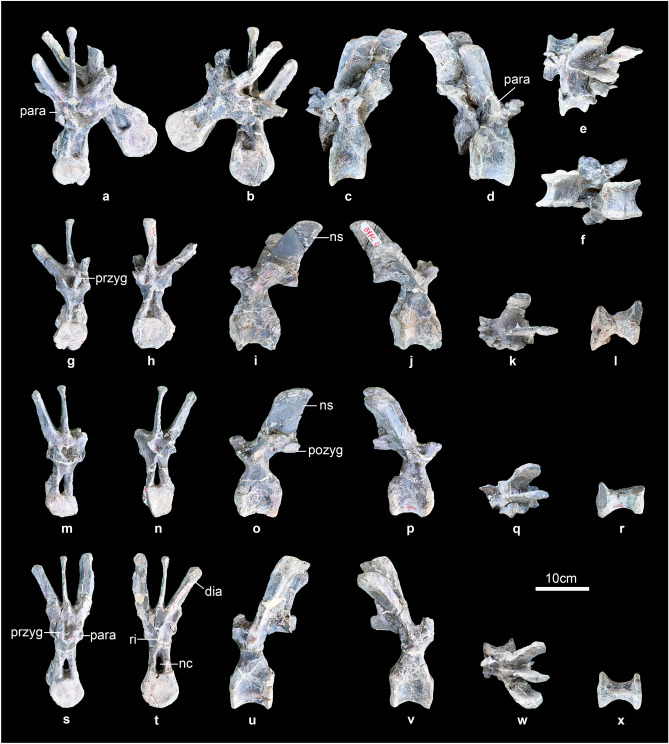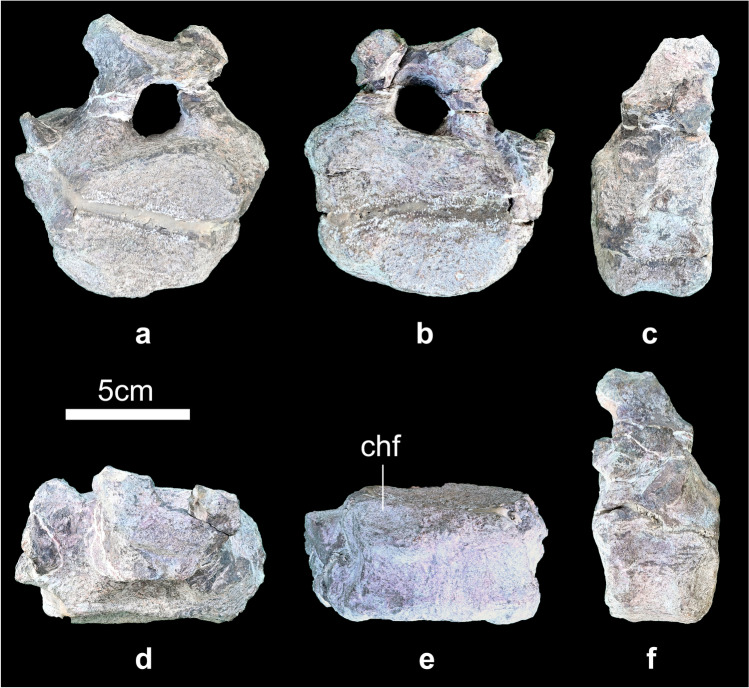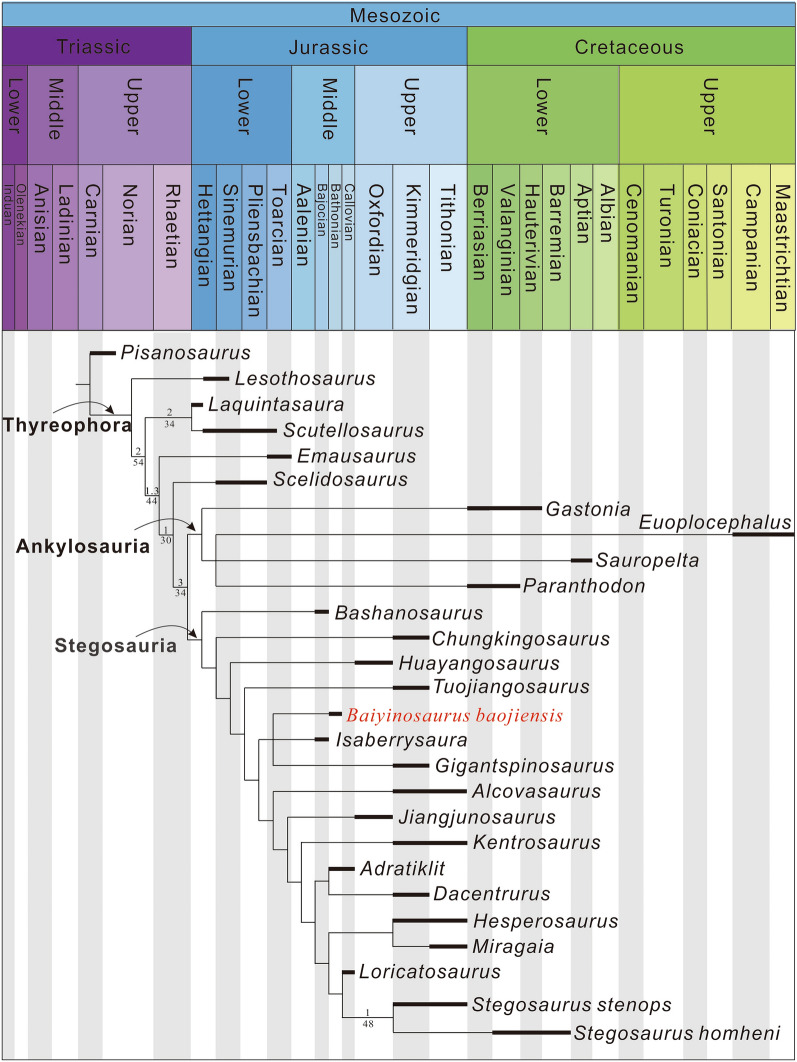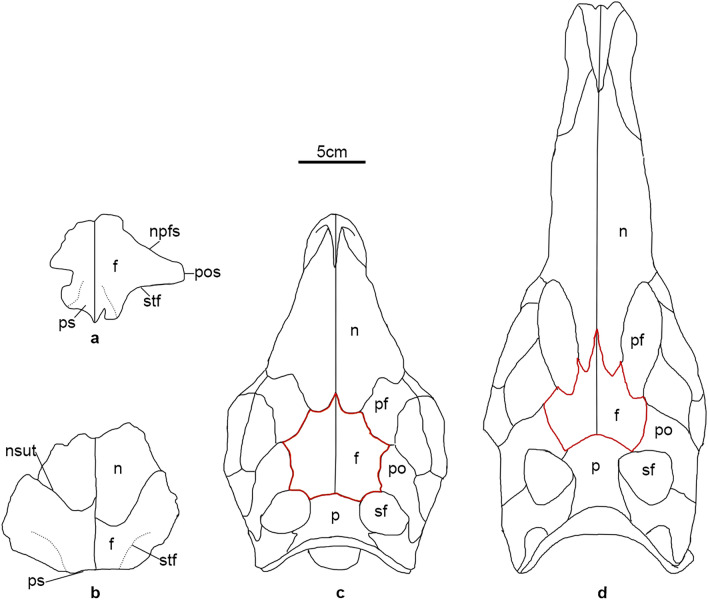Abstract
Stegosaurs are a minor but iconic clade of ornithischian dinosaurs, yet due to a poor fossil record, their early evolution is poorly understood. Here, we describe a new stegosaur, Baiyinosaurus baojiensis, gen. et sp. nov. from the Middle Jurassic Wangjiashan Formation of the Pingchuan District, Baiyin City, Gansu Province, China. The frontal of Baiyinosaurus possesses a unique characteristic among Stegosauria: it is wider than long and contributes to both the medial and anterior margins of the supratemporal fenestra. The character combinations of dorsal vertebrae of Baiyinosaurus are also different to other stegosaurs: its neural arches are not greatly elongated, its parapophyses are well developed, and its neural spines are axially expanded in lateral. The features of the frontal and vertebrae of Baiyinosaurus are reminiscent of basally branching thyreophorans, indicating that Baiyinosaurus is transitional in morphology between early thyreophorans and early-diverging stegosaurs. Systematic analysis shows that Baiyinosaurus is an early-diverging stegosaur.
Keywords: Dinosaur, Stegosaur, Middle Jurassic, Gansu
Subject terms: Palaeontology, Phylogenetics
Introduction
The stegosaurs are characterised by the possession of two parasagittal rows of hypertrophied dermal armour plates and/or spines extending from the neck to the end of the tail and have been found on all continents except for Antarctica and Australia1. The earliest stegosaurs are from the Middle Jurassic, they achieved a global distribution by the Late Jurassic and subsequently waned in diversity during the Early Cretaceous. Records of stegosaurs from the Middle Jurassic are rare, including only five taxa: Loricatosaurus2 from the U.K., Isaberrysaura3 from Argentina, Adratiklit4 from Morocco, and Huayangosaurus5 and Bashanosaurus6 from China.
Dinosaur fossils are abundant in Gansu Province. Since the first dinosaur was discovered in Gansu Province in 19307, seventeen dinosaurian taxa have been discovered and named. Among these named dinosaurs, there are five sauropods including Gobititan shenzhouensis (Titanosauriformes)8, Huanghetitan liujiaxiaensis (Titanosauriformes)9, Daxiatitan binglingi (Titanosauriformes)10, Qiaowanlong kangxii (Brachiosauridae)11, and Yongjinglong datangi (Titanosauria)12; three theropods, including Suzhousaurus megatherioides (Therizinosauroidea)13, Xiongguanlong baimoensis (Tyrannosauroidea)14, and Beishanlong grandis (Ornithomimosauria)15, and nine ornithischians, including Gongpoquanlong mazongshanensis (Hadrosauroidea)16, Archaeoceratops oshimai (Ceratopsia)17, Equijubus normani (Hadrosauroidea)18, Auroraceratops rugosus (Ceratopsia)19, Lanzhousaurus magnidens (Iguanodontia)20, Jintasaurus meniscus (Hadrosauroidea)21, Archaeoceratops yujingziensis (Ceratopsia)22, Xuwulong yueluni (Hadrosauroidea)23, and Taohelong jinchengensis (Ankylosauria)24. Recently, astegosaurian specimen from the Lower Cretaceous Hekou Group of the Zhongpu area, Lanzhou-Minhe Basin, Gansu Province was reported, which is the first stegosaurian dinosaur from Gansu Province25. In 2016, Dr. Li Daqing and his team discovered some dinosaurs, including a stegosaur, several large-sized theropod and sauropod remains and one small theropod track site in Pinchuan District of Baiyin City, Gansu Province. Thereafter, these specimens were excavated and prepared by the Gansu Zhendan Dinosaur Culture Communication Co. Ltd., and they were preserved at Gansu Agricultural University. We herein describe the new stegosaurian dinosaur from the Middle Jurassic of Gansu Province.
Results
Geological setting
The study area is located in the northwestern part of the Baojishan Basin, belonging to the Pinchuan District of Baiyin City, Gansu Province (Fig. 1a,b). The Baojishan Basin is at the eastern end of the Qilian Mountains. It is a fault-bounded subsiding basin, being a small part of the Hexi Corridor Basin, which developed in the Late Triassic and Jurassic. The Middle Jurassic strata of the area is composed of two lithostratigraphic units, the Longfengshan Formation and the Wangjiashan Formation. Underlying these Middle Jurassic strata is a disconformity with Upper Triassic rocks, while Upper Jurassic sediments conformably overlie them26,27. The Straw-yellow Sandstone Member of the Wangjiashan Formation was deposited mainly in a lake deltaic setting, and the succession is characterized by its straw-yellow colour. It changes gradually upward from coarse sandstones at the base to fine sands with interbedded red mudstones in the upper part. The dinosaur fossils were collected from the sandstone of the upper part of the Straw-yellow Sandstone Member of the Wangjiashan Formation (Fig. 1c). Based on its megafossil plants and palynoflora, as well as the lacustrine invertebrate assemblage of the overlying Oil Shale Member, including conchostracans, charophytes, and bivalves, the Straw-yellow Sandstone Member of the Wangjiashan Formation is considered to be late Bathonian in age26–28.
Figure 1.
Locality and geological maps of the fossil locality. (a) map of China showing Gansu Province. (b) map of Gansu showing Baiyin City and Pingchuan District. (c) Geological map of Pingchuan District and the fossil locality.
Systematic palaeontology
Dinosauria Owen29
Ornithischia Seeley30
Thyreophora Nopcsa31
Stegosauria Marsh32
Baiyinosaurus baojiensis gen. et sp. nov.
Holotype
IVPG-D021. A partial skeleton comprising a partial cranium, one cervical vertebra, seven dorsal vertebrae and one caudal vertebra. The measurements of the vertebrae can be found in Table 1.
Table 1.
Measurements (in mm) of vertebrae.
| Element | Centrum length | Anterior facet width | Anterior facet height | Posterior facet width | Posterior facet height | Neural canal height | Neural arch height |
|---|---|---|---|---|---|---|---|
| Atlas (Fig. 4) | 23 | 49 | 8 | 50 | 27 | – | – |
| Second dorsal vertebra (Fig. 5e–j) | 62 | 78 | 58 | 82 | 73 | 34 | 46 |
| Third dorsal vertebra (Fig. 6a–f) | 78 | 69 | 54 | 70 | 68 | 35 | 52 |
| Fourth dorsal vertebra (Fig. 6a–f) | 69 | 75 | 64 | 81 | 55 | 43 | – |
| Fifth dorsal vertebra (Fig. 6g–l) | 78 | 62 | 54 | 71 | 60 | 31 | 56 |
| Sixth dorsal vertebra (Fig. 6m–r) | 84 | 54 | 41 | 50 | 57 | 37 | 57 |
| Seventh dorsal vertebra (Fig. 6s–x) | 81 | 65 | 55 | 68 | 64 | 41 | 65 |
| Caudal vertebra (Fig. 7a–f) | 46 | 71 | 58 | 76 | 62 | 23 | - |
Etymology
Generic name is a combination of Baiyin (the city in which the type locality is located) and saurus (Greek, reptile). The specific name is derived from Baoji (the basin name of the type locality).
Locality and Horizon
Pingchuan District, Baiyin City, Gansu Province, China. GPS coordinates: N36° 44′ 59.1″, E104° 49′ 53.2″. The materials are from the upper part of the Straw-yellow Sandstone Member of the Wangjiashan Formation, whose age is considered to be Middle Jurassic, late Bathonian.
Diagnosis
Baiyinosaurus differs from all other stegosaurs by possession of the following autapomorphy: the frontal is wider than long (score 1 for character 32), and not only contributes to the medial margin of the supratemporal fenestra but also makes up a very great contribution to the anterior margin of the supratemporal fenestra. Baiyinosaurus also possesses the following character combination on dorsal vertebrae: (1) the neural arches are not greatly elongated dorsally: the ratio of neural arch height to neural canal height is 1.59 (character 6, a continuous character); (2) the parapophyses are well developed and project somewhat laterally on stalks in anterior view (score 0 for character 64); (3) the neural spines are anteroposteriorly broad and axially expanded in lateral view: the ratio of neural spine length (measured at the base) to centrum length is 0.75 (character 9, a continuous character).
Description and comparisons
Skull
Some parts of the skull are preserved incompletely, including the left premaxilla (Fig. 2a), frontal (Fig. 2b,c), left maxilla (Fig. 2d–f), right jugal (Fig. 2g,h), and right squamosal (Fig. 2i,j). The skull of Baiyinosaurus is reconstructed in Fig. 2k,l, which is modified from Emausaurus33.
Figure 2.
Skull of Baiyinosaurus baojiensis. (a) left premaxilla (IVPG-D021-01), (b, c) frontal (IVPG-D021-02), (d–f) left maxilla (IVPG-D021-03), (g, h) right jugal (IVPG-D021-04), (i, j) right squamosal (IVPG-D021-05). (a, d, g) lateral view, (b, h, i) dorsal view, (c, f, j) ventral view, (e), medial view. Reconstruction of the skull of Baiyinosaurus in dorsal (k) and lateral (l), modified from Emausaurus33. The yellow areas represent preserved bones. Ap anterior process, d dentary, dp dorsal process, f frontal, j jugal, m maxilla, n nasal, npfs nasal and prefrontal suture, p parietal, pf prefrontal, pm premaxilla, po postorbital, pos postorbital suture, pp posterior process, ps parietal suture, sf supratemporal fossae, sq squamosal, stf margin of supratemporal fenestra, tr teeth row.
Premaxilla: only the posterior part of the left premaxilla is preserved (Fig. 2a). It is an oblique, slightly sinuous, gracile posterolateral process that wedges itself between the maxilla and nasal, similar to Stegosaurus34, Scelidosaurus35 and Emausaurus33. The dorsal margin of the posterolateral process has an obvious transversely expanded contact surface for the nasal.
Maxilla: the anterior and middle parts of the left maxilla are nearly completely preserved, but the anteroventral and posterior parts are missing. The lateral surface of the maxilla is flat (Fig. 2d). The complete tooth row is inset medially from the lateral surface (Fig. 2f), similar to other stegosaurs and most other ornithischians36,37. The dorsolateral surface of the maxilla is laterally compressed, forming a thin lamina that forms the lateral wall of the nasal cavity (Fig. 2e).
Frontal: although the frontal is incomplete (Fig. 2b,c), its overall form is shorter anteroposteriorly than most stegosaurs, but is similar to Tuojiangosaurus38 and the basally branching thyreophorans Scelidosaurus35 and Emausaurus33. It is flat in dorsal view. Posteriorly, the sutural boundaries overlapped by the parietal are clear (Fig. 2b). The right part of the frontal is almost complete and the structure overlapped by the postorbital is visible (Fig. 2b). The end of this structure is narrower anteroposteriorly than Huayangosaurus39 and Stegosaurus34, but more similar to Emausaurus33. Right laterally, the anterior margin has a structure overlapped by the nasal and the prefrontal, and the posterior margin is smooth forming the supratemporal fossae (Fig. 2b). The frontal not only contributes to the medial margin of the supratemporal fenestra but also makes up a much greater contribution to the anterior margin of the supratemporal fenestra than in other stegosaurs, such as Huayangosaurus39, Stegosaurus34 and Kentrosaurus40.
Jugal: a possible jugal is present. The jugal (Fig. 2g,h) is triradiate and contacts postorbital dorsally, maxilla anteriorly and quadratojugal posteroventrally. The end of the anterior process slightly curved dorsally because of fracture. The dorsal process is very broad and extends medially.
Squamosal: a fragment that may represent the dorsal part of the right squamosal is preserved (Fig. 2i,j). It is flat on the dorsal surface and concave on the ventral surface. In dorsal view, the left part has a suture overlapped by the parietal and the right part has a structure overlapped by the postorbital.
Dentary
The left dentary is almost complete and curves medioventrally (Fig. 3a–d). Anteriorly, there are concave facets for the predentary on both the medial and lateral surfaces (Fig. 3a,d). The first dentary tooth arises immediately posterior to these facets for the predentary, with no diastema, similar to the condition in Huayangosaurus39, Gigantspinosaurus (ZDM 0019) and Kentrosaurus (MB.R.3806.1), but in contrast to Stegosaurus41 and Jiangjunosaurus42, where there is a diastema of several tooth-widths between the predentary and the first dentary tooth. A large vascular foramen, the anterior dentary foramen, opens laterally on the dentary and posterior to the predentary area (Fig. 3a). In lateral, the tooth row is visible and sinuous, as in Huayangosaurus39, Gigantspinosaurus (ZDM 0019) and Jiangjunosaurus42 but different to Stegosaurus34, where a lateral lamina in lateral view obscures the tooth row. An external mandibular fenestra is present at the posterior end of the dentary (Fig. 3a). In dorsal view, the tooth row is strongly offset medially and the tooth alveoli face dorsomedially, similar to Stegosaurus34 and Gigantspinosaurus43. There is a row of nutrient foramina lateral to the tooth row in both dorsal and ventral views. The dentary contains eighteen alveoli, in some of which there are teeth in various stages of eruption. In medial view, replacement teeth within resorption pits, lingual to the empty alveoli, are present.
Figure 3.
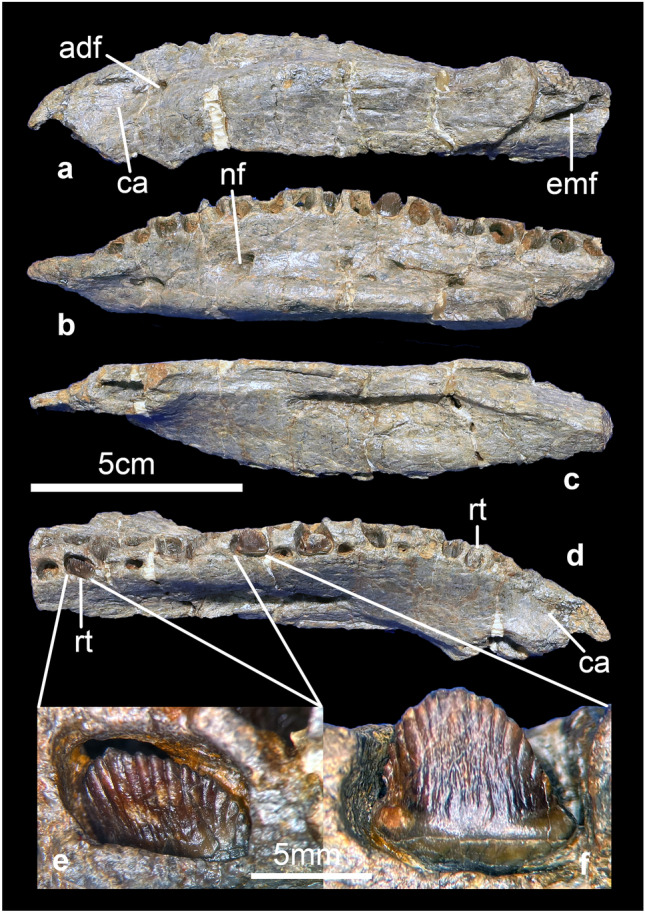
Dentary of Baiyinosaurus baojiensis (IVPG-D021-06). (a–d) left dentary, (e–f) teeth. (a) lateral view, (b) dorsal view, (c) ventral view, (d) medial view, (e, f) lingual view. Adf anterior dentary foramen, ca concave area, emf external mandibular fenestra, nf nutrient foramina, rt replacing teeth.
Teeth
The two complete teeth have seven denticles on either side of two apical denticles (Fig. 3e,f). Tuojiangosaurus also has seven denticles on each side of the tooth crown44. In Stegosaurus, the number of denticles is variable between teeth, and varies between five and nine on either side of two to four apical denticles34 (NHMUK PV R 36730), while in Paranthodon there are four to five denticles on either side of a central one45 (NHMUK PV OR 47338; NHMUK PV R 4992). Striations on the tooth crown are not confluent with marginal denticles, as in most stegosaurs except Paranthodon46. The cingulum is present similar to other stegosaurs except Huayangosaurus, where a swelling at the base of the crown is present, but this is not developed into a distinct cingulum39. Compared to the replacement tooth (Fig. 3e), the functional tooth is slightly worn (Fig. 3f), and its wear facet is inclined anteroventrally or posteroventrally. The microwear of the tooth is similar to Kentrosaurus40, but some stegosaurs have a higher degree of tooth wear, such as in Huayangosaurus39 and Gigantspinosaurus43, and especially the stegosaurian teeth discovered in Montana, USA47 and Yakutia, Eastern Russia48. The higher degree of tooth wear may indicate that the tooth itself is more mature and does not represent an individual’s maturational status47.
Cervical vertebra
The only cervical vertebra preserved is the atlas (Fig. 4a–e). The atlas only preserves the intercentrum. It is saddle-shaped in anterior view (Fig. 4a) and its posterior margin is elevated dorsally in posterior view (Fig. 4b). In Stegosaurus, there are two ridges on the ventral surface of the intercentrum49 which are not present in Baiyinosaurus.
Figure 4.
Atlas of Baiyinosaurus baojiensis (IVPG-D021-07). (a) anterior, (b) posterior, (c) right lateral, (d) dorsal view, (e) ventral view.
Dorsal vertebrae
Seven dorsal vertebrae are preserved including two anterior dorsal vertebrae (Fig. 5a–j) and five middle or posterior dorsal vertebrae (Fig. 6a–x). Only one dorsal vertebra is preserved completely (Fig. 6s–x), and two of the dorsal vertebrae are associated (Fig. 6a–f). The centra of all these dorsal vertebrae are almost amphiplatyan, similar to most stegosaurs. Both the anterior and posterior articular surfaces of the centra are round in outline. The centrum is wider transversely than long anteroposteriorly in the anterior dorsal vertebra (Fig. 5e–h), but are longer than wide in middle and posterior dorsal vertebrae (Fig. 6a–x). The ventral surfaces of the centra are smooth and the ventral margin of the centra is gently concave upwards in lateral view. The neural arch is not greatly expanded dorsally, similar to early-diverging stegosaurs such as Huayangosaurus50 and Gigantspinosaurus43, but different to most other stegosaurs such as Stegosaurus49, Kentrosaurus51 and Tuojiangosaurus44. The neural canal has a sub-ovate outline in anterior and posterior views. The parapophyses of the dorsal vertebra (IVPG-D021-08) are situated at the base of the neural arch and the parapophyses of the dorsal vertebra (IVPG-D021-09) have migrated entirely onto the lateral surface of the neural arch, which is similar to the first and second dorsal vertebrae of Stegosaurus49. However, the parapophyses of the third dorsal vertebra of Stegosaurus49 have migrated onto the upper part of the neural arch, indicating the two anterior dorsal vertebrae of Baiyinosaurus may be the first and second dorsal vertebrae. The parapophyses of five middle or posterior dorsal vertebrae are situated at the base of the diapophyses. In the anterior dorsal vertebrae, the parapophysis has a concave articular surface (Fig. 5a,h). However, the parapophysis is elevated on a short stalk in middle or posterior dorsal vertebrae (Fig. 6a,g,m,s), similar to the early-diverging stegosaur Bashanosaurus6. In the anterior, the prezygapophyses are joined ventrally and face dorsomedially. The articular surfaces of prezygapophyses are flat. In anterior view, the diapophyses extend dorsolaterally at a high angle to the horizontal, similar to most stegosaurs such as Stegosaurus49 and Huayangosaurus50. From the anterior to posterior dorsal vertebrae, the angle to the horizontal of the diapophyses increases. The diapophysis is compressed dorsoventrally. In posterior view, the postzygapophyses are triangular in outline and linked to the neural canal by a ridge, similar to Stegosaurus49. The neural spine projects posterodorsally in lateral view and is a transversely compressed plate in anterior view. The neural spine is significantly elongated anteroposteriorly, similar to Gigantspinosaurus43, but this is developed to a greater degree than in most stegosaurs such as Huayangosaurus50, Stegosaurus49 and Bashanosaurus6.
Figure 5.
(a–j) anterior dorsal vertebrae of Baiyinosaurus baojiensis (IVPG-D021-08 and IVPG-D021-09). (a, g) left lateral, (b, h) right lateral, (c, i) dorsal view, (d, f) posterior, (e) anterior, (j) ventral view. Dia diapophysis, nc neural canal, ns neural spine, para parapophysis, pozyg postzygapophysis, przyg prezygapophysis, ri ridge.
Figure 6.
(a–x) middle or posterior dorsal vertebrae of Baiyinosaurus baojiensis (IVPG-D021-10 to IVPG-D021-14). (a, g, m, s) anterior, (b, h, n, t) posterior, (c, i, o, u) left lateral, (d, j, p, v) right lateral, (e, k, q, w) dorsal view, (f, l, r, x) ventral view. Dia diapophysis, nc neural canal, ns neural spine, para parapophysis, pozyg postzygapophysis, przyg prezygapophysis, ri ridge.
Caudal vertebra
One anterior caudal vertebra is preserved but it is incomplete (Fig. 7a–f). Only the bases of the transverse processes are preserved, and the prezygapophyses, postzygapophyses and neural spine are missing. The anterior and posterior articular surfaces of the centrum are flat and round in outline. The anterior part of the ventral surface of the centrum has a chevron facet (Fig. 7e). The neural canal is round in outline.
Figure 7.
Anterior caudal vertebra of Baiyinosaurus baojiensis (IVPG-D021-15). (a) anterior, (b) posterior, (c) left lateral, (d) dorsal view, (e) ventral view, (f) right lateral. chf chevron facet.
Phylogenetic analysis
A single most parsimonious tree was recovered (Fig. 8). The MPT was 276.06 steps in length and had a consistency index of 0.598 and a retention index of 0.659. Baiyinosaurus is recovered in a clade with Isaberrysaura and Gigantspinosaurus, albeit with low Bremer supports and bootstrap frequencies. Although Paranthodon is generally considered to be a stegosaur, it was found in Ankylosauria in this study. This result may be due to its fragmentary state and highly labile phylogenetic position45.
Figure 8.
A single most parsimonious tree recovered by the phylogenetic analysis. Bremer supports no less than 1 and bootstrap support percentages are indicated above and below the line.
Modified from Dai6.
Discussion
The neurocentral sutures on the dorsal vertebrae are invisible, indicating Baiyinosaurus probably is adult52. Unfortunately, due to a paucity of other bones, we are not able to adequately assess the ontogenetic stage of Baiyinosaurus. Although Baiyinosaurus is clearly a stegosaur based on the elongate neural arch pedicel in dorsal vertebrae and the diapophyses of dorsal vertebrae projecting at a high angle to the horizontal, it has a significant difference from other stegosaurs in the morphology of the skull. The frontal of the Baiyinosaurus is wider than long, different to most stegosaurs except Tuojiangosaurus38 (Fig. 9a–d). However, the frontal of the Baiyinosaurus not only contributes to the medial margin of the supratemporal fenestra but also makes up a much greater contribution to the anterior margin of the supratemporal fenestra than in other taxa, such as Tuojiangosaurus38, Huayangosaurus39 and Stegosaurus34. Besides, Baiyinosaurus has some plesiomorphic characteristics in the vertebrae shared with early-diverging thyreophorans and early-diverging stegosaurs: its neural arch is not greatly expanded dorsally, similar to basally-branching thyreophorans and early-diverging stegosaurs such as Bashanosaurus6, Gigantspinosaurus43 and Hauyangosaurus53. Its parapophysis is well developed and elevated on a short stalk, similar to the early-diverging stegosaur Bashanosaurus6 and the basally branching thyreophoran Scelidosaurus54. It has broad, axially expanded neural spine in lateral view, similar to the condition in the early-diverging stegosaur Gigantspinosaurus43 and the basally branching thyreophorans Scelidosaurus54, Laquintasaura55 and Lesothosaurus56. These character combinations of dorsal vertebrae of Baiyinosaurus are also different to other stegosaurs.
Figure 9.
Outline of the frontal and other skull elements in dorsal view. (a) Baiyinosaurus, (b) Tuojiangosaurus (modified from Maidment and Wei38), (c) Hauyangosaurus (modified from Sereno and Dong39), (d) Stegosaurus (modified from Galton and Upchurch1). F frontal, n nasal, npfs nasal and prefrontal suture, nsut nasal suture; p parietal, pf prefrontal, po postorbital, pos postorbital suture, ps parietal suture, sf supratemporal fossae, sq squamosal, stf margin of supratemporal fenestra.
The diapophyses of the dorsal vertebrae of stegosaurs projecting dorsolaterally at a high angle to the horizontal is one of the most obvious differences compared to basally branching thyreophorans. Baiyinosaurus and other early-diverging stegosaurs such as Bashanosaurus6 and Gigantspinosaurus43 show that features generally considered to be characteristic of stegosaurs, such as the elongated neural arch and parapophyses located at the base of the diapophyses as flattened, oval facets were acquired gradually during stegosaur evolution. First, there was a gradual increase in the angle of projection of the diapophyses of the dorsal vertebrae: they project horizontally in basally branching thyreophorans such as Scutellosaurus57 and Laquintasaura55, slightly dorsolaterally in Scelidosaurus54 and project dorsolaterally at a high angle in stegosaurs, even in the early-diverging stegosaurs Baiyinosaurus and Bashanosaurus6. The neural spine changed from anteroposteriorly broad to being narrower anteroposteriorly during thyreophoran evolution: the neural spine is axially expanded in basally-branching thyreophorans such as Scelidosaurus54, Laquintasaura55 and Lesothosaurus56, and early-diverging stegosaurs such as Baiyinosaurus, but is narrower in the early-diverging stegosaur Bashanosaurus6 and other stegosaurs. Finally, the parapophysis was elevated on a short stalk in the basally branching thyreophoran Scelidosaurus54, and early-diverging stegosaurs Baiyinosaurus and Bashanosaurus6, but is not elevated in later-diverging stegosaurs, and is instead present as a facet on the lateral surface of the neural arch ventral to the diapophysis.
The basally-branching thyreophorans, the ancestors of the stegosaurs, are all from the Early Jurassic, including Scelidosaurus54 from England, Emausaurus33 from Germany, Lesothosaurus56,58,59 from South Africa, Scutellosaurus57,60,61 from the United States, Laquintasaura55 from Venezuela and the poorly known Tatisaurus62,63 and Bienosaurus64,65 from China. Although the earliest tracks of possible stegosaurs are from the Early Jurassic1, the earliest bones of stegosaurs are found in the Middle Jurassic4. Baiyinosaurus has some character states that indicate it was transitional in morphology between the basally branching thyreophorans and the stegosaurs, and is also from the Middle Jurassic, indicating a Middle Jurassic (or much earlier) origin for the split between Stegosauria and its sister taxon Ankylosauria is likely.
Conclusions
Baiyinosaurus is a new taxon and represents one of the earliest records of Stegosauria. Systematic analysis shows that Baiyinosaurus is an early-diverging stegosaur closed to Isaberrysaura, Alcovasaurus, Jiangjunosaurus and Gigantspinosaurus. Baiyinosaurus has some plesiomorphic characteristics and is transitional in morphology between early thyreophorans and early-diverging stegosaurs. The increasing diversity of Middle Jurassic stegosaurs that also occupy early-diverging positions indicates that it is likely that the stegosaurs split from their sister taxon, the ankylosaurs, early in the Middle Jurassic (or much earlier).
Methods
Phylogenetic analysis. To assess the phylogenetic position of Baiyinosaurus, it is added to the character-taxon matrix of Dai et al.6. The matrix (updated from Maidment et al.4) is based on Raven and Maidment66 which originally comprised 23 taxa scored for 115 characters. We added two new characters to the dataset: 9. Dorsal vertebrae: neural spines length (measured at the base) to centrum length ratio coded continuously. 64. Dorsal vertebrae: parapophyses are well developed that held on stalks at the base of the diapophyses; (0); poorly developed (1). The data matrix consists of 27 taxa scored for 117 morphological characters. The character list and data matrix can be found in supplementary A and B. The matrix was analyzed in TNT v1.567. Pisanosaurus68 was set as the outgroup. All continuous characters (1–25) and characters 108 and 109 were ordered. A New Technology search was performed using sectorial, ratchet, drift and tree fusing options and 10 random addition sequences. The most parsimonious trees (MPTs) recovered from the New Technology search were used as the starting point for a round of tree bisection-reconnection (TBR) using the Traditional Search option with one random addition seed and 1000 replicates. Support for the relationships obtained was evaluated using Bremer support and bootstrap analysis (1000 replicates, traditional search). Nomenclatural acts: The nomenclatural acts it contains have been registered in ZooBank, the online registration system for the ICZN. The ZooBank LSIDs (Life Science Identifiers) can be resolved and the associated information viewed through any standard web browser by appending the LSID to the prefix ‘http://zoobank.org/’. The LSID for this publication is: urn:lsid:zoobank.org:pub:5A2665F4-F3D0-4519-808C-E4CEC8E07E00.
Supplementary Information
Acknowledgements
We wish to thank Gansu Zhendan Dinosaur Culture Communication Co. Ltd. for their field assistance and the preparation of the specimen. We also appreciate the thoughtful reviews provided by Dr. Attila Ősi and another anonymous reviewer, as well as the editor who contributed to enhancing an earlier version of this manuscript.
Abbreviations
- IVPG
Institute of Vertebrate Paleontology, Gansu Agricultural University
- MB
Museum für Naturkunde, Berlin, Germany
- NHMUK
Natural History Museum, London, UK
- ZDM
Zigong Dinosaur Museum, Zigong, Sichuan Province, People’s Republic of China
Author contributions
L.N., L.D., Y.H. and P.G. wrote the main manuscript text. S.M. provided comparative data and helped with English language editing. L.N. and P.G. prepared all the figures and measured the specimens. L.D. and Y.H. oversaw the project. All authors reviewed the manuscript.
Funding
This research was supported by the Scientific Innovative Fund of Gansu Agricultural University (Grant Nos. 066-056001) and the National Natural Science Foundation of China (Grant No. 42288201, 42372030).
Data availability
All data generated or analysed during this study are included in this published article and its supplementary information fles.
Competing interests
The authors declare no competing interests.
Footnotes
Publisher's note
Springer Nature remains neutral with regard to jurisdictional claims in published maps and institutional affiliations.
Supplementary Information
The online version contains supplementary material available at 10.1038/s41598-024-66280-x.
References
- 1.Galton, P. M. & Upchurch, P. Stegosauria. In The Dinosauria (2nd edition) (eds. Weishampel D. B. et al.) 343–362 (University of California Press, 2004).
- 2.Nopcsa F. Notes on British dinosaurs IV: Stegosaurus priscus sp. nov. Geol. Mag. 1911;8:109–115. doi: 10.1017/S0016756800110714. [DOI] [Google Scholar]
- 3.Salgado L, Canudo JI, Garrido AC, Moreno-Azanza M, Martínez LCA, Coria RA, et al. A new primitive Neornithischian dinosaur from the Jurassic of Patagonia with gut contents. Sci. Rep.-UK. 2017;7:42778. doi: 10.1038/srep42778. [DOI] [PMC free article] [PubMed] [Google Scholar]
- 4.Maidment SCR, Raven TJ, Ouarhache D, Barrett PM. North Africa's first stegosaur: Implications for Gondwanan thyreophoran dinosaur diversity. Gondwana Res. 2020;77:82–97. doi: 10.1016/j.gr.2019.07.007. [DOI] [Google Scholar]
- 5.Dong ZM, Tang ZL, Zhou SW. Note on the new Mid-Jurassic stegosaur from Sichuan Basin, China. Vertebr. Palasiat. 1982;20:84–88. [Google Scholar]
- 6.Dai H, Li N, Maidment SCR, Wei GB, Zhou YX, Hu XF, et al. New Stegosaurs from the Middle Jurassic Lower member of the Shaximiao formation of Chongqing. China. J. Vertebr. Paleontol. 2022;41:e1995737. [Google Scholar]
- 7.Bohlin B. Fossil reptiles from Mongolia and Kansu. Sino-Swedish Exped. Publ. 1953;37:1–113. [Google Scholar]
- 8.You HL, Tang F, Luo ZX. A new basal titanosaur (Dinosauria: Sauropoda) from the Early Cretaceous of China. Acta Geol. Sin. 2003;77:424–429. doi: 10.1111/j.1755-6724.2003.tb00123.x. [DOI] [Google Scholar]
- 9.You HL, Li DQ, Zhou LQ, Ji Q. Huanghetitan liujiaxiaensis, a new sauropod dinosaur from the Lower Cretaceous Hekou Group of Lanzhou Basin, Gansu Province, China. Geol. Rev. 2006;5:668–674. [Google Scholar]
- 10.You HL, Li DQ, Zhou L, Ji Q. Daxiatitan Binglingi: A giant Sauropod dinosaur from the Early Cretaceous of China. Gansu Geol. 2008;17:1–10. [Google Scholar]
- 11.You HL, Li DQ. The first well-preserved Early Cretaceous brachiosaurid dinosaur in Asia. Proc. R. Soc. B Biol. Sci. 2009;276:4077–4082. doi: 10.1098/rspb.2009.1278. [DOI] [PMC free article] [PubMed] [Google Scholar]
- 12.Li LG, Li DQ, You HL, Dodson P, Butler RJ. A new titanosaurian sauropod from the Hekou Group (Lower Cretaceous) of the Lanzhou - Minhe Basin, Gansu Province, China. Plos One. 2014;2014:e85979. doi: 10.1371/journal.pone.0085979. [DOI] [PMC free article] [PubMed] [Google Scholar]
- 13.Li DQ, Peng C, You HL, Matthew CL, Jerald DH, Kenneth JL, et al. A large Therizinosauroid (Dinosauria:Theropoda) from the Early Cretaceous of Northwestern China. Acta Geol. Sin. 2007;81:539–549. doi: 10.1111/j.1755-6724.2007.tb00977.x. [DOI] [Google Scholar]
- 14.Li DQ, Norell MA, Gao KQ, Smith ND, Makovicky PJ. A longirostrine tyrannosauroid from the Early Cretaceous of China. Proc. R. Soc. B Biol. Sci. 2010 doi: 10.1098/rspb.2009.0249. [DOI] [PMC free article] [PubMed] [Google Scholar]
- 15.Makovicky PJ, Li DQ, Gao KQ, Lewin M, Erickson GM, Norell MA. A giant ornithomimosaur from the Early Cretaceous of China. Proc. R. Soc. B Biol. Sci. 2010;277:191–198. doi: 10.1098/rspb.2009.0236. [DOI] [PMC free article] [PubMed] [Google Scholar]
- 16.Lü, J. C. A New Iguanodontidae (Probactrosaurus mazongshanensis sp. nov.) from Mazongshan Area, Gansu Province, China. In Sino-Japanese Silk Road Dinosaur Expedition (ed. Dong Z. M.) 27–47 (China Ocean Press, 1997).
- 17.You HL, Peter D. Redescription of neoceratopsian dinosaur Archaeoceratops and early evolution of Neoceratopsia. Acta Palaeontol. Pol. 2003;48:261–272. [Google Scholar]
- 18.You HL, Luo ZX, Shubin NH, Witmer LM, Tang ZL, Tang F. The earliest-known duck-billed dinosaur from deposits of late Early Cretaceous age in northwest China and hadrosaur evolution. Cretac. Res. 2003;24:347–355. doi: 10.1016/S0195-6671(03)00048-X. [DOI] [Google Scholar]
- 19.You HL, Li DQ, Ji Q, Matthew CL, Peter D. On a new genus of basal neoceratopsian dinosaur from the Early Cretaceous of Gansu Province, China. Acta Geol. Sin. 2005;79:593–597. [Google Scholar]
- 20.You HL, Ji Q, Li DQ. Lanzhousaurus magnidens gen. et sp. Nov. from Gansu Province, China; the largest-toothed herbivorous dinosaur in the world. Geol. Bull. China. 2005;24:785–794. [Google Scholar]
- 21.You HL, Li DQ. A new basal hadrosauriform dinosaur (Ornithischia: Iguanodontia) from the Early Cretaceous of northwestern China. Can. J. Earth Sci. 2009;46:949–957. doi: 10.1139/E09-067. [DOI] [Google Scholar]
- 22.You, H. L., Tanoue K & Dodson, P. A new species of Archaeoceratops (Dinoasuria: Neoceratopsia) from the Early Cretaceous of the Mazongshan Area, northwestern China. In New perspectives on Horned Dinosaurs (eds. Ryan M. J. et al.) 59–67 (Indiana University Press, 2010).
- 23.You HL, Li DQ, Liu WC. A new hadrosauriform dinosaur from the early cretaceous of Gansu Province, China. Acta Geol. Sin. 2011;85:51–57. doi: 10.1111/j.1755-6724.2011.00377.x. [DOI] [Google Scholar]
- 24.Yang JT, You HL, Li DQ, Kong DL. First discovery of polacanthine ankylosaur dinosaur in Asia. Vertebr. Palasiat. 2013;51:265. [Google Scholar]
- 25.Li N, Li DQ, Peng GZ, You HL. The first stegosaurian dinosaur from Gansu Province, China. Cretac. Res. 2024;158:105852. doi: 10.1016/j.cretres.2024.105852. [DOI] [Google Scholar]
- 26.Li BX, Xu FX, Ma QH, Pan HZ, Wang SQ, Li ZW. Middle Jurassic Strata of Wangjiashan Basin, Jingyuan, Gansu. J. Stratigr. 1982;6:33–40. [Google Scholar]
- 27.Zhang H, He ZL, Jin XL, Zhang H, Li GH, Yang ZY, et al. Sedimentary environments and coal accumulation of the Baojishan-Honghui Basin, eastern Qilian Mountains. Acta Sedmentlolgica Sin. 2009;27:622–631. [Google Scholar]
- 28.Du BA. Sporo-pollen assemblages from the Middle Jurassic in the Wangjiashan Basin of Jingyuan, Gansu, and their stratigraphic and paleogeographic significance. Geol. Rev. 1985;31:131–141. [Google Scholar]
- 29.Owen R. Report on British fossil reptiles. Rep. Br. Assoc. Adv. Sci. 1842;11:60–204. [Google Scholar]
- 30.Seeley HG. The classification of the Dinosauria. Rep. Br. Assoc. Adv. Sci. 1888;58:698–699. [Google Scholar]
- 31.Nopcsa F. Die Dinosaurier der Seibenbürgishcen Landisteile Ungarns. Mitteilungen aus dem Jahrbuche der Königlich Ungarischen Geologischen Reichsanstalt. 1915;23:1–26. [Google Scholar]
- 32.Marsh OC. A new Order of extinct Reptilia (Stegosauria) from the Jurassic of the Rocky Mountains. Am. J. Sci. 1877;3:34–35. [Google Scholar]
- 33.Haubold H. Ein neuer Dinosaurier (Ornithischia, Thyreophora) aus dem unteren Jura des nordlichen Mitteleuropa. Revue de paleobiologie. 1990;9:149–177. [Google Scholar]
- 34.Gilmore CW. Osteology of the armoured Dinosauria in the United States National Museum, with special reference to the genus Stegosaurus. US Natl. Museum Bull. 1914;89:1–143. [Google Scholar]
- 35.Norman DB. Scelidosaurus harrisonii from the Early Jurassic of Dorset, England: Cranial anatomy. Zool. J. Linn. Soc.-Lond. 2019;188:1–81. doi: 10.1093/zoolinnean/zlz074. [DOI] [Google Scholar]
- 36.Maidment SCR, Norman DB, Barrett PM, Upchurch P. Systematics and phylogeny of Stegosauria (Dinosauria: Ornithischia) J. Syst. Palaeontol. 2008;6:367–407. doi: 10.1017/S1477201908002459. [DOI] [Google Scholar]
- 37.Butler RJ, Upchurch P, Norman DB. The phylogeny of the ornithischian dinosaurs. J. Syst. Palaeontol. 2008;6:1–40. doi: 10.1017/S1477201907002271. [DOI] [Google Scholar]
- 38.Maidment SCR, Wei GB. A review of the Late Jurassic stegosaurs (Dinosauria, Stegosauria) from the People's Republic of China. Geol. Mag. 2006;143:621–634. doi: 10.1017/S0016756806002500. [DOI] [Google Scholar]
- 39.Sereno PC, Dong ZM. The skull of the basal stegosaur Huayangosaurus taibaii and a cladistic diagnosis of Stegosauria. J. Vertebr. Paleontol. 1992;12:318–343. doi: 10.1080/02724634.1992.10011463. [DOI] [Google Scholar]
- 40.Galton PM. Skull bones and endocranial casts of stegosaurian dinosaur Kentrosaurus Hennig, 1915 from Upper Jurassic of Tanzania, East Africa. Geol. Palaeontol. 1988;22:123–143. [Google Scholar]
- 41.Berman DS, Mcintosh JS. Description of the lower jaw of Stegosaurus (Reptilia, Ornithischia) Ann. Carnegie Mus. 1986;55:29–40. doi: 10.5962/p.330593. [DOI] [Google Scholar]
- 42.Jia CK, Forster CA, Xu X, Clark J. The first stegosaur (Dinosauria, Ornithischia) from the Upper Jurassic Shishugou Formation of Xinjiang, China. Acta Geol. Sin. 2007;81:351–356. doi: 10.1111/j.1755-6724.2007.tb00959.x. [DOI] [Google Scholar]
- 43.Hao BQ, Zhang QN, Peng GZ, Ye Y, You H. Redescription of Gigantspinosaurus sichuanensis (Dinosauria, Stegosauria) from the Late Jurassic of Sichuan, Southwestern China. Acta Geol. Sin. 2018;92:431–441. doi: 10.1111/1755-6724.13535. [DOI] [Google Scholar]
- 44.Dong ZM, Zhou SW, Zhang YH. Dinosaurs from the Jurassic of Sichuan. Palaeontol. Sin. 1983;162:1–151. [Google Scholar]
- 45.Raven TJ, Maidment SCR. The systematic position of the enigmatic thyreophoran dinosaur Paranthodon africanus, and the use of basal exemplifiers in phylogenetic analysis. PeerJ. 2018;6:e4529. doi: 10.7717/peerj.4529. [DOI] [PMC free article] [PubMed] [Google Scholar]
- 46.Galton PM, Coombs WP. Paranthodon africanus (Broom), a stegosaurian dinosaur from the Lower Cretaceous of South Africa. Geobios-Lyon. 1981;14:299–309. doi: 10.1016/S0016-6995(81)80177-5. [DOI] [Google Scholar]
- 47.Woodruff C, Trexler D, Maidment SCR. Two new stegosaur specimens from the Upper Jurassic Morrison Formation of Montana, USA. Acta Palaeontol. Pol. 2019;64:461–480. doi: 10.4202/app.00585.2018. [DOI] [Google Scholar]
- 48.Skutschas PP, Gvozdkova VA, Averianov AO, Lopatin AV, Martin T, Schellhorn R, et al. Wear patterns and dental functioning in an Early Cretaceous stegosaur from Yakutia, Eastern Russia. Plos One. 2021;16:e248163. doi: 10.1371/journal.pone.0248163. [DOI] [PMC free article] [PubMed] [Google Scholar]
- 49.Maidment SCR, Brassey C, Barrett PM. The Postcranial Skeleton of an Exceptionally Complete Individual of the Plated Dinosaur Stegosaurus stenops (Dinosauria: Thyreophora) from the Upper Jurassic Morrison Formation of Wyoming, USA. Plos One. 2015;10:e138352. doi: 10.1371/journal.pone.0138352. [DOI] [PMC free article] [PubMed] [Google Scholar]
- 50.Zhou, S. W. The Middle Jurassic Dinosaurian Fauna from Dashanpu, Zigong, Sichuan, Volume 2: Stegosaurs 1–55 (Sichuan Scientific and Technological Publishing House, 1984).
- 51.Hennig E. Kentrosaurus aethiopicus, der Stegosauridae des Tendaguru. Sitzungsberichte der Gesellschaft Naturforschender Freunde zu Berlin. 1915;1915:219–247. [Google Scholar]
- 52.Irmis R. Axial skeleton ontogeny in the Parasuchia (Archosauria: Pseudosuchia) and its implications for ontogenetic determination in archosaurs. J. Vertebr. Paleontol. 2007;27:350–361. doi: 10.1671/0272-4634(2007)27[350:ASOITP]2.0.CO;2. [DOI] [Google Scholar]
- 53.Maidment SCR, Wei GB, Norman DB. Re-description of the postcranial skeleton of the Middle Jurassic stegosaur Huayangosaurus taibaii. J. Vertebr. Paleontol. 2006;26:944–956. doi: 10.1671/0272-4634(2006)26[944:ROTPSO]2.0.CO;2. [DOI] [Google Scholar]
- 54.Norman DB. Scelidosaurus harrisonii from the Early Jurassic of Dorset, England: postcranial skeleton. Zool. J. Linn. Soc.-Lond. 2020;189:47–157. doi: 10.1093/zoolinnean/zlz078. [DOI] [Google Scholar]
- 55.Barrett PM, Butler RJ, Mundil R, Scheyer TM, Irmis RB, Sanchez-Villagra MR. A palaeoequatorial ornithischian and new constraints on early dinosaur diversification. Proc. R. Soc. B Biol. Sci. 2014;281:20141147. doi: 10.1098/rspb.2014.1147. [DOI] [PMC free article] [PubMed] [Google Scholar]
- 56.Baron MG, Norman DB, Barrett PM. Postcranial anatomy of Lesothosaurus diagnosticus (Dinosauria: Ornithischia) from the Lower Jurassic of southern Africa: implications for basal ornithischian taxonomy and systematics. Zool. J. Linn. Soc.-Lond. 2017;179:125–168. [Google Scholar]
- 57.Breeden BT, Raven TJ, Butler RJ, Rowe TB, Maidment SCR. The anatomy and palaeobiology of the early armoured dinosaur Scutellosaurus lawleri (Ornithischia: Thyreophora) from the Kayenta Formation (Lower Jurassic) of Arizona. R. Soc. Open Sci. 2021;8:201676. doi: 10.1098/rsos.201676. [DOI] [PMC free article] [PubMed] [Google Scholar]
- 58.Barrett PM, Butler RJ, Yates AM, Baron MG, Choiniere JN. New specimens of the basal ornithischian dinosaur Lesothosaurus diagnosticus Galton, 1978 from the Early Jurassic of South Africa. Palaeontol. Afr. 2016;50:48–63. [Google Scholar]
- 59.Galton PM. Fabrosauridae, the basal family of ornithischian dinosaurs (Reptilia: Ornithopoda) Paläontol. Z. 1978;52:138–159. doi: 10.1007/BF03006735. [DOI] [Google Scholar]
- 60.Colbert, E. H. A Primitive ornithischian dinosaur from the Kayenta formation of Arizona 1–55 (Museum of Northern Arizona Press, 1981).
- 61.Rosenbaum JN, Padian K. New material of the basal thyreophoran Scutellosaurus lawleri from the Kayenta Formation (Lower Jurassic) of Arizona. Paleobios. 2000;20:13–23. [Google Scholar]
- 62.Norman DB, Butler RJ, Maidment SCR. Reconsidering the status and affinities of the ornithischian dinosaur Tatisaurus oehleri Simmons, 1965. Zool. J. Linn. Soc.-Lond. 2007;150:865–874. doi: 10.1111/j.1096-3642.2007.00301.x. [DOI] [Google Scholar]
- 63.Simmons DJ. The non-therapsid reptiles of the Lufeng Basin, Yunnan, China. Fieldiana Geol. 1965;15:1–93. [Google Scholar]
- 64.Raven T, Barrett P, Xu X, Maidment SCR. A reassessment of the purported ankylosaurian dinosaur Bienosaurus lufengensis from the Lower Lufeng Formation of Yunnan, People's Republic of China. Acta Palaeontol. Pol. 2019 doi: 10.4202/app.00577.2018. [DOI] [Google Scholar]
- 65.Dong, Z. M. Primitive armoured dinosaur from the Lufeng Basin, China. In Mesozoic Vertebrate Life (eds. Tanke D. H. et al.) 237–242 (Indiana University Press, 2001).
- 66.Raven TJ, Maidment SCR. A new phylogeny of Stegosauria (Dinosauria, Ornithischia) Palaeontology. 2017;60:401–408. doi: 10.1111/pala.12291. [DOI] [Google Scholar]
- 67.Goloboff PA, Farris JS, Nixon KC. TNT, a free program for phylogenetic analysis. Cladistics. 2008;24:774–786. doi: 10.1111/j.1096-0031.2008.00217.x. [DOI] [Google Scholar]
- 68.Casamiquela RM. Un nuevo dinosaurio ornitischio Triásico (Pisanosaurus mertii: Ornithopoda) de la Formación Ischigualasto, Argentina. Ameghiniana. 1967;4:47–64. [Google Scholar]
Associated Data
This section collects any data citations, data availability statements, or supplementary materials included in this article.
Supplementary Materials
Data Availability Statement
All data generated or analysed during this study are included in this published article and its supplementary information fles.



